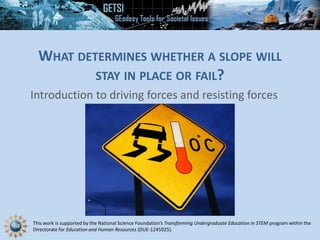Unit 3 physical factors lecture slides
•Download as PPTX, PDF•
0 likes•100 views
Report
Share
Report
Share

Recommended
More Related Content
What's hot
What's hot (18)
Unit 3 Part 2 Presentation - Material Strength and Landsliding Assessment

Unit 3 Part 2 Presentation - Material Strength and Landsliding Assessment
CBSE Class 8 Topic Force and Pressure - TopperLearning

CBSE Class 8 Topic Force and Pressure - TopperLearning
Similar to Unit 3 physical factors lecture slides
Similar to Unit 3 physical factors lecture slides (20)
More from SERC at Carleton College
More from SERC at Carleton College (20)
Cretaceous Coatlines and Modern Voting Patterns Presentation

Cretaceous Coatlines and Modern Voting Patterns Presentation
Presentation: Unit 1 Introduction to the hydrological cycle

Presentation: Unit 1 Introduction to the hydrological cycle
Presentation: Unit 2 Measuring Groundwater Background Information

Presentation: Unit 2 Measuring Groundwater Background Information
Unit 3 physical factors lecture slides
- 1. This work is supported by the National Science Foundation’s Transforming Undergraduate Education in STEM program within the Directorate for Education and Human Resources (DUE-1245025). WHAT DETERMINES WHETHER A SLOPE WILL STAY IN PLACE OR FAIL? Introduction to driving forces and resisting forces
- 2. DRIVING FORCES VS RESISTING FORCES GRAVITY FRICTION promotes sliding resistance to sliding Which of the following Earth system scenarios will increase the risk of slope failure? (a) Increase gravity (b) Increase friction (c) Reduce gravity (d) Reduce friction
- 3. DRIVING FORCES Force = mass x acceleration Force: A push or pull in a particular direction measured in Newtons (kg m/s2 = N) F = ma Weight (force of gravity) = mass x acceleration due to gravity Gravity is a mass-dependent force directed downward towards the center of the Earth. Acceleration due to gravity = 9.8m/s2 W = mg W = FG The downward-directed force is dependent on the mass of block.
- 4. DRIVING FORCES 10 kg block 100 kg block Which block exerts the greater downward directed force? Why?
- 5. DRIVING FORCES – ON A SLOPE! FN = Normal Force = perpendicular to the sloping surface FS = Shear Force = parallel to the sloping surface q = Slope Angle On a slope, the force due to gravity consists of two components: Shear Force (FS) Normal Force (FN)W = FG FS FN q In the diagram above: Which force increases friction and keeps the block in place? Which force pulls the block down the slope?
- 6. CALCULATING DRIVING FORCES– ON A SLOPE! FN = Normal Force = perpendicular to the sloping surface FS = Shear Force = parallel to the sloping surface q = Slope Angle W = FG FS FN q FS = W sin q FN = W cos q
- 7. FORCE VS STRESS sN = Normal Stress sS = Shear Stress q = Slope Angle Stress is the force acting over a specific area. In other words: Stress (s) = Force/Area W = FG FS FN q sS = FS/A sN = FN/A A area between the block and sloping plane l w
Editor's Notes
- https://en.wikipedia.org/wiki/File:Panneau_routier_Qu%C3%A9bec_gel_au_sol_-_Gasp%C3%A9.jpg
- Should we explain the trig here? S=O/H, Sin = FS/W (little force triangle, also a right triangle with the FS and FN perpendicular.